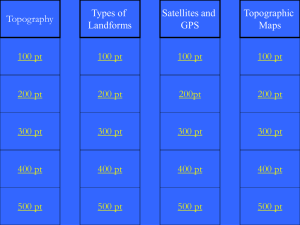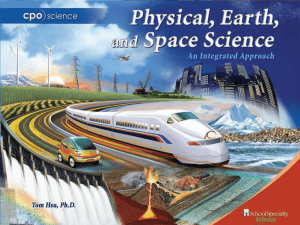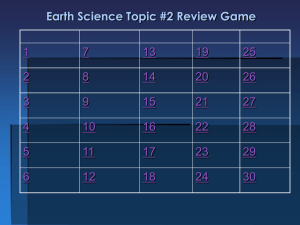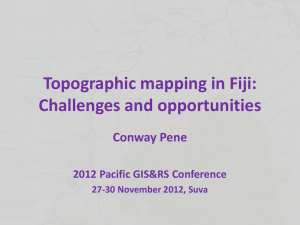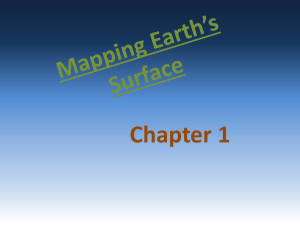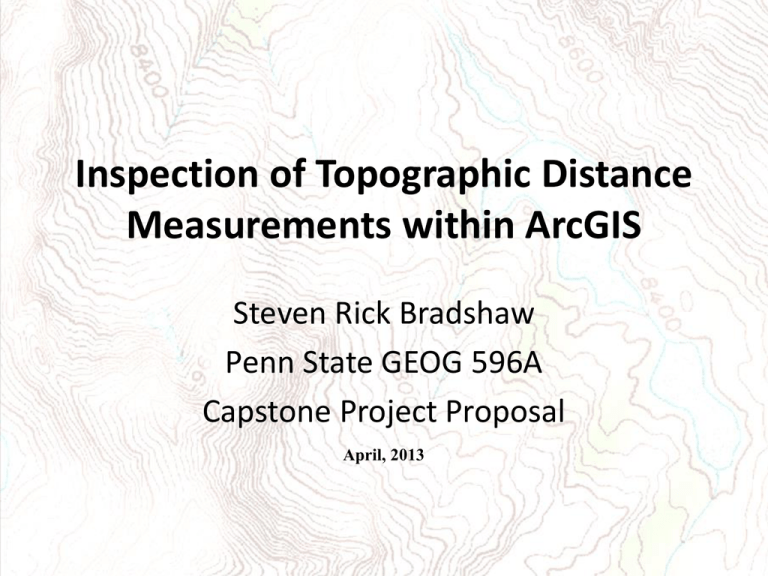
Inspection of Topographic Distance
Measurements within ArcGIS
Steven Rick Bradshaw
Penn State GEOG 596A
Capstone Project Proposal
April, 2013
Background - Issues with GIS Measurements
• In a non-projected global coordinate system, GIS software measures
geodetic distances using the surface of a reference ellipsoid.
• Geodetic distance: “…the length of the shortest curve between those two
points along the surface of the earth model being used by the spatial
reference system. Geodetic distance behaves well for wide areas of coverage,
and takes the earth's curvature into account.”
The OpenGIS Consortium
Background - Issues with GIS Measurements
• Geodetic distance measurements using a reference ellipsoid, will not
consider changes in elevation between two points.
• Compared to geodetic distances, topographic distances can be much longer.
• The following scenario will illustrate the need for a tool within GIS software
that measures topographical distances.
• Currently, GIS software tools offered by major vendors, do not provide an
accurate analysis of topographic distances.
• The results of this study will suggest the need to develop appropriate tools
that compute topographic distance within GIS software.
Background - Issues with GIS Measurements
Scenario
Consider two cities (A and B) separated by
a mountain range. When traveling from
City A to City B, a traveler changes elevation
crossing over the summit of the range.
When GIS software calculates the distance
between City A and B, the resultant distance
is calculated using geodetic (or planar)
distance but does not include the changes
in topography.
Background - Previous Research on Problem
Literature Review
Currently, there is little research on topographic distance measurement
within a GIS environment.
Previous and current research on GIS based distance measurements can
be classified into three categories
1.
Methods used in ArcGIS to Measure Geodetic and Euclidean Distances
I.
II.
III.
IV.
Euclidean Distance
Geodetic Distances
Cost-Weighted Distance
Proximity Analysis
Background - Previous Research on Problem
Literature Review Continued …
2. Distance Measurement Algorithm Development
I.
Meyer’s Topographic Distance Watershed Algorithm
Utilizes watershed lines to calculate geodetic distances. It also uses slope to calculate the
topographic distances of water traveling toward the minimum watershed line values from a
chosen starting point.
II.
Yang’s cell based algorithm for evaluating Directional Distance
Identifies the nearest object borderlines to a given point within the map. The
algorithm pre-processes a map into a grid, identifies the nearest object borderline
and creates radiating “fetch lines” in multiple directions.
Background - Previous Research on Problem
Literature Review Continued…
3.
Research on Issues with Current Distance Measurement Methodology.
I.
Liu et al. (2007) examined the effects of raster cell resolution on Cost Distance
Modeling.
II.
Hunghu et al. (2011) studied on the effects of DEM cell resolution on slope length
calculations.
III.
Napieralski and Napela (2008) investigated the effect of DEM cell resolution on
landform morphology.
Proposed Methodology
Research Approach
Hypothesis- Given the same route,
topographic distances would be greater
than geodetic distances.
Two sections of Highway 70 that traverses
White Sands Missile Range, NM will be
mapped with GPS and cast in WGS-84 and
NAD27.
1. Organ Mountain Site - a route over a
mountain pass with moderate elevation
changes.
2. Flats Site – a route across an extinct
lakebed with little elevation change.
Proposed Methodology
Research Approach
Organ Mountain SiteHighway 70 is a four lane divided, with high
rate of traffic. Speed limit ranges from 50
to 75 MPH within study site.
Length- 18 km
Elevation- 3,963 ft. to 5,719 ft at the Pass
Proposed Methodology
Research Approach
Flats SiteIs also a four lane divided highway,
with high rate of traffic. Speed limit
is 75 MPH within study site.
Length- 3 km
Elevation- 3,955 ft. to 3,998 ft
Proposed Methodology Cont…
Research Steps – Data Collection
1. Physical survey of study sites
• Relative GPS surveying methods
will be used to survey both sites
collecting coordinates every 150 meters.
These WGS-84 coordinates will be used
to generate topographic distances.
• Orthometric heights are determined
by calculating the relationship of
ellipsoid heights above the reference
ellipsoid and the heights of the geoid
The results are comparable to the
traditional elevation values of a
vertical datum.
Trimble R-8 Receivers
Proposed Methodology Cont…
Research Steps – Data Collection
The Survey at Flat Site
In addition to the GPS survey, the Flats Site
will measure the actual surface distance
with a device (measuring wheel). This
distance will be used as a baseline of the
surface distance to be compared to the
measured geodetic distance and the GPS
collected Topographic distance.
Proposed Methodology Cont…
Research Steps – Data Collection
2. Transform Horizontal Coordinates to NAD27
To illustrate how different reference ellipsoids can affect topographic distances,
coordinates of both sites will be transformed into the North American Datum of
1927 (NAD27) using survey processing software.
3. Transform Vertical Coordinates to NGVD29
NAD27 elevation values collected during the survey will be cast in the National
Geodetic Vertical Datum of 1929 (NGVD29).
Proposed Methodology Cont…
Research Steps – Data Collection Continued…
4. Modify Vertical data for Organ Mountain Pass Site
All vertical data for the Organ Mountain Pass Site will be manipulated to represent
extreme elevation changes.
5. Generate Slant Distances of all Datasets
Topographic distances will be calculated with DoD software using 3 dimensional
coordinates (x, y, z) of two points on a reference ellipsoid, then calculating the
slant distance between those points.
Proposed
Methodology
Cont..
Proposed
Methodology
Dataset Workflow
Elevation
Manipulation
Organ Mountain
Site
WGS-84
Transform
NAD27
Organ Mountain
Site
WGS-84
Organ Mountain
Site
NAD27
Transform
NGVD29
Organ Mountain
Site
NAD27/NGVD29
Flats Site
WGS-84
Transform
NAD27
Slant Dist.
Flats Site
NAD27
Organ Mountain
Extreme Elevation
WGS-84
Organ Mountain
WGS-84 Extreme
Slant Distance
Slant Dist.
Organ Mountain
WGS-84
Slant Distance
Organ Mountain
Site
NAD27/NGVD29
Slant Dist.
Elevation
Manipulation
Organ Mountain
Extreme Elevation
WGS-84
Slant Dist.
Slant Dist.
Organ Mountain
NAD27
Slant Distance
Organ Mountain
NAD27 Extreme
Slant Distance
Slant Dist.
Flats Site WGS-84
Slant Distance
Flats Site NAD27
Slant Distance
Proposed Methodology Cont…
Research Steps – Data Analysis
6. Comparison of Reference Ellipsoids
WGS-84 is a geocentric reference system ellipsoid with an origin at center of Earth’s mass.
• The orientation of the system is oriented and fixed to astronomic observations.
NAD27 is a horizontal control datum that utilizes the Clarke Spheroid of 1866.
• The origin is a single survey marker at Meade's Ranch, Kansas.
• The origin of NAD27’s reference ellipsoid, Clarke 1866 is approximately 236 meters away
from WGS-84 Earth-centered Earth-fixed reference ellipsoid. The orientation of these
reference ellipsoids differ by nearly 11 minutes of angle, with NAD27 tilted counterclockwise to WGS 84. (Roman, 2007)
Ellipsoid
Semi-Major Axis
Semi-minor Axis
Flattening
WGS-84
6,378,137.0 m
6,356,752.314 m
1/298.257223563
NAD27 (Clarke
1866)
6,378,206.4 m
6,356,583.8 m
1/294.9786982
NAD27 is 69.m wider at
equatorial plane
WGS-84 is 168.514m
taller between poles
Comparison
Proposed Methodology Cont…
Research Steps – Data Analysis Cont…
7. Comparing Distances
Topographic distance results of all six routes will be compared to the geodetic and
actual surface distance. The actual surface distance of the Flats Site will also be
compared to the topographic and geodetic distances.
WGS-84 topographic distance will be compared to the NAD27 topographic and
actual surface distance data.
8. Explore Data
It is expected any differences in distances will be caused by both the physical
distinctions in the dimensions of the reference ellipsoids and the orthometric
heights and the NGVD29 elevation values.
Anticipated Results
The following results are anticipated.
1. The greater the elevation changes between two locations, the greater
the difference between the geodetic and topographic distance.
2. The topographical distance of datasets with extreme elevation changes
will be much greater than the geodetic distance.
3. Datasets with smaller elevation changes will have similar topographic
and geodetic distances.
4. The differences in the topographic distances between WGS-84 and
NAD27 will highlight the importance of selecting the proper reference
ellipsoid and its application for a particular geographic region.
The results will illustrate the need for and warrant further study into
developing a function within GIS software that measures topographical
distances.
Project Timeline
May to June 2013 Complete Steps 1, 2, 3
• Identify and establish a study area.
• GPS the study area and process the data.
• Transform WGS-84 horizontal coordinates to NAD27.
• Transform WGS-84 orthometric heights to NGVD29 elevation values.
July 2013- Complete Steps 4 and 5
• Complete research on WGS-84 and NAD27 and conduct a discussion on the differences between WGS-84
and NAD27 in respect to New Mexico to identify causes of differences in topographic distances.
• Create new routes by modifying elevation values.
August 2013- Complete Steps 6, 7 and 8
• Calculate slant distances of all routes to create topographic distances.
• Analyze all topographic and geodetic distances.
• Compare and contrast the differences of topographic and geodetic distances.
September to November 2013- GEOG 596B
• Prepare for presentation for formal professional presentation.
• Present results of capstone at the North American Cartographic Society Conference in Greenville, South
Carolina October, 2013.
References
A.
B.
C.
D.
E.
F.
G.
H.
I.
J.
K.
L.
M.
N.
Defense Mapping Agency. 1984. Geodesy for the Layman. Washington, D.C. Available at
http://www.ngs.noaa.gov/PUBS_LIB/Geodesy4Layman/TR80003A.HTM
ESRI. (n.d.). GIS Dictionary. Retrieved from http://support.esri.com/en/knowledgebase/GISDictionary/term/Clarke ellipsoid of
1866
Open Geospatial Consortium, T. C. (2007, December 28). Schema for Coverage Geometry and Functions. Retrieved from
http://www.opengeospatial.org/standards/as
Hoghu, L., Kessel, J., Hormann, G., & Fohrer, N. (2011). Effects of DEM Horizontal Resolution and Methods on Calculating the
Slope Length Factor in Gently Rolling Landscapes. Catena, 368-375. Retrieved from http://ac.elscdn.com.ezaccess.libraries.psu.edu/S0341816211001408/1-s2.0-S0341816211001408-main.pdf?_tid=afdd1c1a-87771-11e2ba1b-00000aacb35f
Liu, W., Chen, D., & Scott, N. A. (2007, August). In Peng Gong (Chair). Effects of Cell Sizes on Resistance Surfaces in GIS-based Cost
Distance Modeling for Landscape Analyses. Paper submitted at: Geoinformatics 2007: Geospatial Information Technology and
Applications, Nanjing, China. doi: 10.1117/12.764597
Meyer, F. (1994). Topographic Distance and Watershed Lines. Signal Processing, 113 - 125. Retrieved from
http://www.sciencedirect.com/science/article/pii/0165168494900604
Napieralski, J., & Nalepa, N. (2010). The application of control charts to determine the effect of grid cell size on landform
morphology. Computers and Geosciences, 222-230. Retrieved from
http://sciencedirect.comezaccess.libraries.psu.edu/science/article/pii/S0098300409002428
NGA. National Geospatial-Intelligence Agency (2009, June 16). Egm2008- WGS 84 Version. Retrieved from http://earthinfo.nga.mil/GandG/wgs84/gravitymod/egm2008/egm08_wgs84.html
NH.GOV. New Hampshire State Government (2007), Flood Plain Management. (2007). NGVD to NAVD. Retrieved from website:
http://www.nh.gov/oep/programs/floodplainmanagement/documents/NGVDtoNAVD.pdf
NIMA. National Imagery and Mapping Agency, (2000). Department of Defense World Geodetic System 1984 (TR8350.2). Retrieved
from website: http://earth-info.nga.mil/GandG/publications/tr8350.2/tr8350_2.html
NOAA. (2009, June 03). Geodetic Glossary. Retrieved from http://www.ngs.noaa.gov/CORSProxy/Glossary/xml/NGS_Glossary.xml
Roman, D.A.(2007) Datums, Heights and Geodesy. Central Chapter of the Professional Land Surveyors of Colorado 2007 Annual
Meeting, Colorado. Retreived from
http://www.ngs.noaa.gov/GEOID/PRESENATIONS/2007_02_24_CCPS/Roman_A_PLSC2007notes.pdf
Wolf, P., & Ghilani, C. (2006). Elementary Surveying: An Introduction to Geomatics. (11th ed., pp. 549-550). Upper Saddle River,
New Jersey: Pearson Prentice Hall.
Yang, S., Yong, J. H., & Sun, H. G. (2010). A Cell Based Algorithm for Evaluating Directional Distances in GIS. International Journal of
Geographical Information Science, 24(4), Retrieved from
http://www.tandfonline.com.ezaccess.libraries.psu.edu/doi/abs/10.1080/13658810902988419
Questions and Answers?

